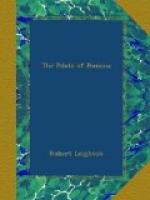The story of the wreck of the Undine gave me many matters to ponder over. But the one practical thing that I learnt was this existence of a cave in the North Gaulton cliffs. I had not known that there was such a cave at that spot, although, indeed, I prided myself upon my knowledge of the whole coastline from Rora to Birsay. I accordingly determined to explore the cliff at some future time.
Chapter XIX. Tom Kinlay’s Bargain.
I must not omit to mention that Willie Hercus and Robbie Rosson duly delivered up to Mr. Drever their shares of Jarl Haffling’s treasure. The dominie was, I believed, already in communication with the proper authorities concerning the claims that would be imposed according to what he called the law of treasure trove. But there were many delays in coming to an agreement, owing, as I understood, to official indifference and to the difficulty of determining the value of the relics, which Mr. Drever contended were worth more than their mere weight in silver. Meanwhile, the schoolmaster, anxious to keep the collection, as he said, intacto, for preservation in some museum, still held possession of the antiquities, and was nightly burning much oil in his absorbed study of them.
Since Tom Kinlay had left the school Mr. Drever had not seen him. But, betimes, a message was sent by Thora to intimate to Tom that we others had given our parts of the viking’s treasure into his charge, and advising that Tom should send in the remainder without delay. But Tom, who now owed no direct duty to the dominie, resolutely refused to give up his share of the treasure.
On a windy Saturday morning—a week after the death of my poor dog—I was loitering about the quays in the port, when I was attracted towards a little crowd that had gathered round an old capstan. The crowd consisted of several sailors and fishermen, with a sprinkling of townsfolk, who were evidently much interested in something that was going on in their midst.
I walked towards them and elbowed my way in beside old Davie Flett, the skipper of a coasting schooner, with whom I was slightly acquainted.
“What’s all the stir, Mr. Flett?” I asked.
“Och, it’s just an auld Jew doing some business,” he replied; and I pressed my way further into the crowd.
In the middle of the group there was a withered little man, bent with age, with a long ragged beard and a nose like the beak of a hawk. He wore a great black coat that was very shiny and reached almost down to his ankles; and in his skinny fingers he held what I soon recognized as the large red stone that Tom Kinlay had found at Skaill. Tom himself was standing near the old Jew, and bargaining with him for all the treasure that had fallen to his share.
The Jew had made some offer for the gem when I came up, and Kinlay was deliberating whilst listening to the advice of the fishermen.




